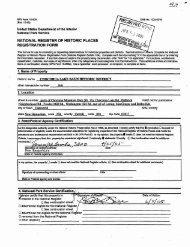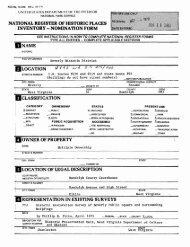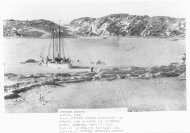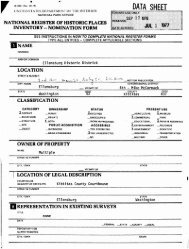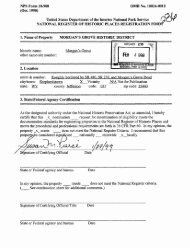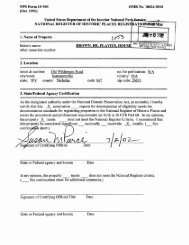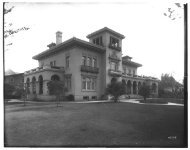National Register of Historic Places Registration Form
National Register of Historic Places Registration Form
National Register of Historic Places Registration Form
You also want an ePaper? Increase the reach of your titles
YUMPU automatically turns print PDFs into web optimized ePapers that Google loves.
NFS <strong>Form</strong> 10-9004 0MB Approval No. 1024-0018<br />
(M6)<br />
United States Department <strong>of</strong> the Interior<br />
<strong>National</strong> Park Service<br />
<strong>National</strong> <strong>Register</strong> <strong>of</strong> <strong>Historic</strong> <strong>Places</strong><br />
Continuation Sheet<br />
CLEVELAND PARK HISTORIC DISTRICT<br />
WASHINGTON D.C.<br />
Section number 8 page 24<br />
strained. In 1902 the Shermans moved out <strong>of</strong> their home in Cleveland Park. In<br />
1903 the Washington Times ran an article calling Cleveland Park the "Queen <strong>of</strong><br />
Washington suburbs: Cleveland Park is the prettiest suburb <strong>of</strong> Washington."<br />
1904 is the last year that the Cleveland Park Company appears in the City<br />
Directory. It was also the year the Shermans hired Moore and Hill, a real<br />
estate firm formed in 1900, to be their exclusive agents and to put out a real<br />
estate brochure to promote the sale <strong>of</strong> Cleveland Park houses. Their success<br />
was documented by the Washington Post <strong>of</strong> 1909: "in 8 weeks alone they sold<br />
over $200,000 worth <strong>of</strong> property in Cleveland Park." It seems clear that a<br />
major effort was underway to sell as much real estate in Cleveland Park as<br />
possible. As a consequence <strong>of</strong> his financial difficulties Waggaman's land<br />
holdings had to be sold which altered the prospects <strong>of</strong> the Cleveland Park<br />
Company. The Shermans 1 were able to retain ownership <strong>of</strong> the land at the lower<br />
end <strong>of</strong> Newark and Macomb Streets and continued to develop it until 1909, after<br />
which time John and Ella Bennett Sherman disappeared from the city<br />
directories.<br />
It is possible that many <strong>of</strong> the houses built during the second phase were<br />
designed by John Sherman 1 s wife who had been an active participant in the<br />
business from its earliest days. Ella Bennett Sherman (1850-1926) was a<br />
trained artist who had attended the Art Student's League in New York city and<br />
who had studied with Robert Henri, William Merritt Chase and Douglas Volk. In<br />
Washington she exhibited oil and watercolor paintings with the Washington<br />
Water Color Club and the Society <strong>of</strong> Washington Artists between 1904 and 1922.<br />
In 1923 she is listed in Who's Who in the Nation"s Capital *(1923-24, pp. 336-<br />
7), and the article says she had "designed and planned many suburban<br />
residences <strong>of</strong> <strong>National</strong> Capital and other Cities." The evidence, including a<br />
signed blueprint, suggests that Ella Bennett Sherman became the architect for<br />
the Cleveland Park Company after Head's departure. Some <strong>of</strong> her designs bear a<br />
resemblance to the last houses designed by Robert Head so she may have worked<br />
with him and learned architecture from him as an apprentice (which was<br />
standard practice for aspiring architects at the turn <strong>of</strong> the century before<br />
licensing laws were introduced).<br />
John Sherman must have been proud <strong>of</strong> his streetcar suburb. He had the<br />
vision to hire architects to design original houses which were subsequently<br />
published in architectural journals such as the American Architect and<br />
Building News, and in popular trend-setting magazines like the Ladies Home<br />
Journal. The Moore and Hill real estate brochure and the article in the<br />
Washington Times on May 10, 1903 give glowing reports about Cleveland Park<br />
and the advantages <strong>of</strong> owning a house in the neighborhood.<br />
Thomas Waggaman's bankruptcy and the necessity to liquidate his land<br />
holdings made land available to new developers. A new thrust appeared in the<br />
Cleveland Park brochure <strong>of</strong> 1904 aimed at attracting individual buyers <strong>of</strong> more<br />
modest means and developers who might buy lots to build houses on speculation.<br />
*(Cleveland Park, originally published by Moore and Hill in 1904, reprinted in<br />
1982 by the Columbia <strong>Historic</strong>al society, with an introduction by Kathleen<br />
Sinclair Wood, last page <strong>of</strong> the original text advertises the prices.) One such<br />
developer who was attracted by the <strong>of</strong>fer was John L. Warren, who purchased at



